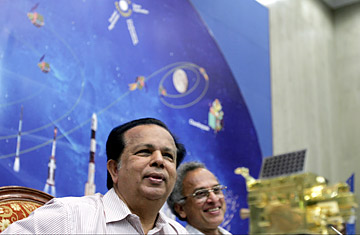
Indian Space Research Organization chief Madhavan Nair, left, and Principal Scientist Chandrayaan-1, J.N. Goswami after finding the presence of water on the lunar surface.
India's space agency has taken its share of hits over the years. When it was set up in the 1960s, the Bangalore-based organization's very existence was questioned by critics — both inside and outside India — who said a poor country should worry about feeding hungry millions before firing rockets into space. Last month, there were allegations of incompetence after India's first-ever lunar probe, Chandrayaan-I, was lost when its communications system shut down. So this week's announcement that the same probe, fitted with a NASA research instrument, had found water on the surface of the moon (and managed to send the data back to earth before losing contact) was a welcome reason to cheer at the Indian Space Research Organization (ISRO). "Water ice on the moon has been something of a holy grail for lunar scientists for a very long time," Jim Green, director of the Planetary Science Division at NASA Headquarters in Washington said in a press release. "This surprising finding has come about through the ingenuity, perseverance and international cooperation between NASA and the India Space Research Organization."
Indian newspapers were ecstatic: "One Big Step For India, A Giant Leap for Mankind," read the headline in the Times of India. ISRO chairman G. Madhavan Nair was beaming when he told reporters on Friday that "India should be proud that Chandrayaan discovered water on the moon It is acknowledged the world over that this is a real discovery and a path-breaking event for the Indian space agency."
The discovery is remarkable for several reasons. Since the Apollo program four decades ago, scientists have believed the surface of the moon to be dry. Moisture found in rocks brought back by those early missions were thought to be the result of contamination from the earth's atmosphere. The new research, which used the intensity of the colors that bounce off the surface of the moon when it's hit by sunlight, proves that there are traces of both water and a closely related molecule called hydroxyl. Scientists now believe water could be produced in the lunar soil when hydrogen from solar winds combines with oxygen-rich substances on the lunar surface. Another theory centers on water-laden comets and meteorites hitting the moon.
Chandrayaan-I was launched last October; the ISRO lost contact with it in late August. At the time, critics questioned the program's worth and the need for future missions. But ISRO scientists say they simply underestimated the radiation levels the probe and its communication system would face, problems they will now fix. The water discovery was vindication that they had got a lot right and the hiccup, said chairman Nair last week, was all part of a normal learning curve. The ISRO, Nair told reporters, is "100% satisfied with the mission's objectives."
Even getting this far has been an achievement itself. A lunar mission has been consistently opposed by sections of India's political and scientific community ever since it was proposed in 1999. Critics question the logic of a country battling dire poverty spending millions of dollars on scientific pursuits that they liken to reinventing the wheel. They said the ISRO should stick to socially relevant research as it did after its establishment in 1969: launching satellites for landscape and resource mapping, weather forecasting, or communications and educational broadcasts.
But after overseeing successful nuclear tests in 1998 and riding high on nationalist euphoria over breaching international non-proliferation norms, the right-wing, BJP-led National Democratic Alliance government agreed to an ambitious moon program. Then Prime Minister Atal Bihari Vajpayee, who approved Chandrayaan-I at the Independence Day function on August 15, 2003, said he wanted India's space program to become one of the best in the world. Supporters of the program argued that a lunar mission would provide untold technological spin-offs. Many of those same enthusiasts now say they have been vindicated. Operating a satellite at a distance ten times beyond anything they had done before has given the ISRO valuable experience in hi-tech spacecraft, rocketry and advanced remote navigation technology. At $79 million, the program's budget also comes in way under those by many competitors.
The ISRO now wants to land a craft on the moon by 2013 and has reaffirmed its commitment to sending a mission to Mars by 2015. ISRO wants to garner a larger share of the increasingly competitive commercial satellite launch market. On Thursday, it launched six European and Turkish satellites from its Polar Satellite Launch Vehicle. "[The] returns, in terms of the science, the technology, inspiration, stature, prospects for international cooperation... are immense," K. Kasturirangan, former ISRO chairman who conceived Chandrayaan-I, told TIME before the launch. It doesn't hurt that the country's celebrating too.
